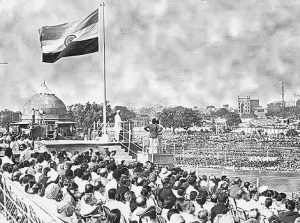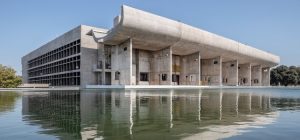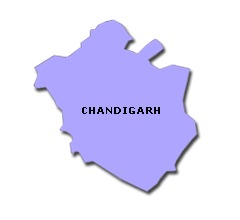DIGITAL NEWS GURU HISTORICAL DESK:
Chandigarh: A Shared Capital Reflecting the Unique History of Punjab and Haryana
Punjab and Haryana, two neighboring states in northern India, share a unique and fascinating characteristic: they both have the same capital, Chandigarh. This arrangement, while unusual, is a product of historical, political, and cultural circumstances that arose during the tumultuous period of Indian independence and partition.
To fully understand why Punjab and Haryana share Chandigarh as their capital, it’s essential to explore the region’s history, the political decisions that shaped the states, and the symbolic importance of Chandigarh itself.
Historical Context: The Partition of India

The story begins with the partition of British India in 1947, which led to the creation of India and Pakistan as separate nations. Punjab, a region that straddled both countries, was divided along religious lines, with the eastern part remaining in India and the western part becoming part of Pakistan.
The division of Punjab was accompanied by mass migrations, communal violence, and the displacement of millions of people. Lahore, the historic capital of undivided Punjab, became part of Pakistan, leaving Indian Punjab without a capital.
In the immediate aftermath of partition, Shimla served as the temporary capital of Indian Punjab. However, Shimla’s location in the hills was not ideal for a state that needed a centrally located capital to facilitate governance and administration. The need for a new capital was urgent, and the Indian government began looking for a suitable site.
The Birth of Chandigarh

The decision to build a new city from scratch was bold and unprecedented in independent India. The site chosen for the new capital was near the foothills of the Shivalik range in present-day Haryana, close to the Punjab-Haryana border. The city was named Chandigarh, after the Chandi Mandir, a temple dedicated to the Hindu goddess Chandi near the site.
The design and construction of Chandigarh were entrusted to the famous Swiss-French architect Le Corbusier, who envisioned the city as a modern, well-planned urban center that would symbolize India’s aspirations for a progressive future. Chandigarh was designed with broad avenues, ample green spaces, and a distinct grid pattern, making it one of India’s most well-planned cities.
In 1966, India underwent a significant reorganization of states based on linguistic lines. Punjab was divided into two states: Punjab and Haryana. Punjab, with a Sikh and Punjabi-speaking majority, retained the name Punjab, while the newly formed Haryana had a Hindi-speaking majority. The reorganization was intended to address linguistic and cultural differences and provide better governance. However, the division of Punjab also posed a new challenge: the question of which state would get Chandigarh as its capital.
Chandigarh: A Union Territory

The division of Punjab raised the question of what to do with Chandigarh, which was geographically located in what was now Haryana but had been built to serve as the capital of Punjab. To resolve this dilemma, the Indian government decided to designate Chandigarh as a Union Territory, directly administered by the central government. This arrangement allowed both Punjab and Haryana to use Chandigarh as their capital while avoiding potential disputes over its ownership.
Chandigarh’s status as a Union Territory means that it is not part of either Punjab or Haryana, but rather a distinct administrative entity. It serves as the capital for both states, with separate legislative assemblies and administrative functions for each state housed in the city. This arrangement, though practical, was seen as a temporary solution, and there were plans to eventually transfer Chandigarh to Punjab, with Haryana building its own capital.
The Symbolic Significance of Chandigarh

Chandigarh holds a unique place in India’s post-independence history. It was the first planned city in independent India and has since become a symbol of modernity, order, and progress. The city represents the aspirations of a newly independent nation striving to break free from its colonial past and chart its own course. Le Corbusier’s design for Chandigarh, with its emphasis on functionality and aesthetics, was a radical departure from the organic, often chaotic growth patterns of older Indian cities.
For Punjab and Haryana, Chandigarh is more than just an administrative capital; it is a shared symbol of their intertwined histories and cultural connections. The city’s architecture, culture, and demographics reflect the blending of influences from both states. Chandigarh has a cosmopolitan character, with residents from various parts of India contributing to its unique identity.
The Ongoing Debate Over Chandigarh
Despite its success as a shared capital, the issue of Chandigarh’s ownership has remained a point of contention between Punjab and Haryana. Over the years, there have been demands from Punjab to transfer Chandigarh entirely to its jurisdiction, while Haryana has sought to retain its share of the capital. The central government’s decision in 2019 to allocate land in Haryana for a new administrative complex for the state in Panchkula was seen as a step toward resolving the issue, but the debate continues.
The situation is further complicated by the fact that Chandigarh has grown significantly since its inception and is now a thriving urban center with its own distinct identity. The city’s residents, many of whom have lived there for generations, often see themselves as distinct from the populations of Punjab and Haryana, adding another layer of complexity to the issue.
Conclusion
The shared capital of Chandigarh is a product of historical necessity, political compromise, and visionary urban planning. It stands as a testament to the challenges and opportunities that arose in the wake of India’s independence and the subsequent reorganization of its states. While the arrangement may have been intended as a temporary solution, Chandigarh has evolved into a vibrant city that embodies the shared heritage of Punjab and Haryana.
As India continues to grow and change, the question of Chandigarh’s future remains open. However, for now, it continues to serve as a unique and enduring symbol of the region’s complex history and the pragmatic solutions that have shaped India’s political landscape.
YOU MAY ALSO READ: National Space Day: Celebrating India’s Lunar Legacy and Scientific Milestones








